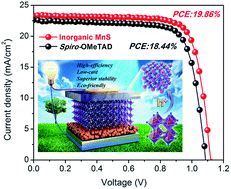Perovskite solar cells employing an eco-friendly and low-cost inorganic hole transport layer for enhanced photovoltaic performance and operational stability†
Abstract
Environmental concerns and the high cost of some key components are the main obstacles to the practical applications of perovskite solar cells (PSCs). Herein, a novel, eco-friendly and lost-cost MnS film was developed and employed as an efficient inorganic hole transport layer (HTL) of PSCs for the first time via the technique of vacuum vapor deposition. Benefiting from its good optical transparency, high hole mobility and suitable band alignment, an excellent power conversion efficiency (PCE) of 19.86% was achieved in the optimized device with an inorganic HTL of manganese sulfide (MnS) without any further interface optimization. More importantly, the MnS-based devices demonstrated superior stability over their counterparts with organic HTLs; they retained over 90% of their initial efficiency even after exposure to air with a relative humidity of 80% for 1000 h without any encapsulation. It also remarkably improved the thermal stability of the devices than their organic counterparts. These results highlight the great potential of the MnS HTL for achieving eco-friendly, cost-effective and stable photovoltaic devices.



 Please wait while we load your content...
Please wait while we load your content...